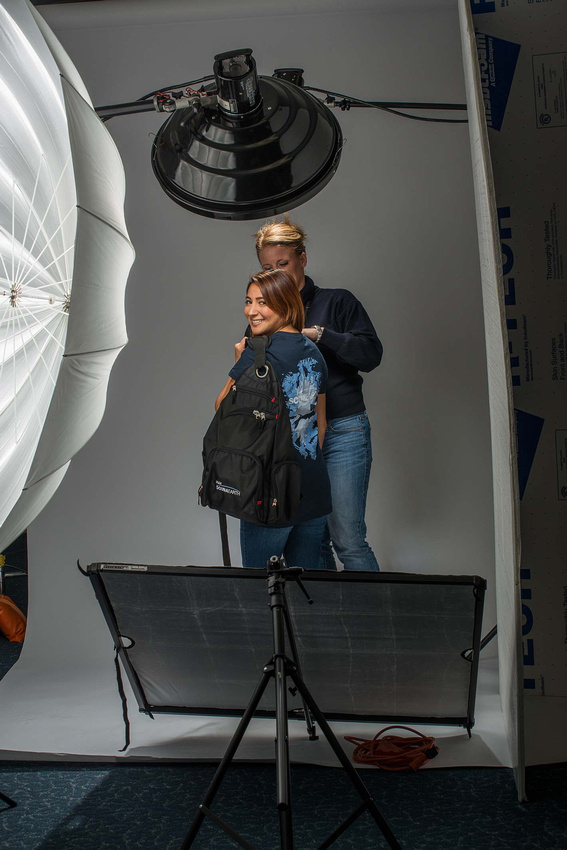Counting Lights
 How can you lose shooting a beautiful young lady with the wind in her hair? Studio shoot for ScubaEarth.com.
How can you lose shooting a beautiful young lady with the wind in her hair? Studio shoot for ScubaEarth.com.
Check out this shot for a behind the scenes look.
Pop quiz: How many lights did we use to create this image of ScubaEarth.com fashion wear?
Two?
Try again.
Three?
More.
Four?
Getting warm
Five?
Not quite.
The answer is six lights.
If you're not familiar with studio fashion imaging, you may be surprised that such a simple shot (it should look simple) takes so many lights. It's not a matter of brightness, but a matter of shape. When we're imaging, we use lights as chisels that carve the illusion of three dimensions from a two dimensional photo. Each light does a different job in what you hear called "lighting," but which is actually just as much shadowing. Here's a behind the scenes shot:
 A quick adjustment while shooting some Scubaearth.com fashion items.
A quick adjustment while shooting some Scubaearth.com fashion items.
Looking at this, there are six, but only five are visible. First, hidden by the model (and my PA Niccole in this shot) is a strobe head you can't see, but if you shoot, you should be able to tell it's there because it illuminates the backdrop. Then, there is a strobe shooting through the umbrella on frame left, another strobe head with the beauty dish (light with big round reflector at top of frame), and a strobe hair light that you can see just behind the beauty dish. That's four. The last two lights are the big silver reflector below the model angled up at her, and the V-flat on frame right.
At this point, some may be screaming that reflectors are reflectors, not lights. Without getting into an argument with Webster, no, from a photographic point of view, reflectors are lights just as much as strobes are. Whether it is a strobe, reflector, a wall, ceiling, someone in a white dress or whatever, photographically, anything that sends enough light towards the subject to be visible in the captured image must be treated as a light that is subject to all the principles of lighting (inverse square law, family of angles, hardness proportional to two-dimensional relative size, etc.)
Failure to think in these terms commonly cause problems lighting and learning to light. Photographers sometimes decide that something is or is not a light based on whether it emits photons instead of whether it changes the light falling on, and reflecting from, the subject. Or, they only consider something a light if they placed it to light the subject. Either is a mistake because it neglects the fact that light is light, even if it's a stray reflection off a broken Coke bottle 20 feet out of frame, and therefore affects the shot. A professional photographer or photographic artist doesn't neglect this because you can't get reliable results any other way.
If you hear someone say "I didn't use any lights for this shot," it's only true if the person then shows you a black rectangle. Otherwise, the person either doesn't understand, photographically speaking, what a light is, or the person doesn't know how to count.
Comments
|
January
February
March
(4)
April (4)
(2)
May (2)
(2)
June (2)
(1)
July (1)
(2)
August (2)
(1)
September (1)
(1)
October (1)
(1)
November (1)
(1)
December (1)
|
(1)
January (1)
(1)
February (1)
(1)
March (1)
(1)
April (1)
(1)
May (1)
(1)
June (1)
(1)
July (1)
(1)
August (1)
(1)
September (1)
(1)
October (1)
November
(1)
December (1)
|
(1)
January (1)
February
(1)
March (1)
April
(1)
May (1)
June
(1)
July (1)
(1)
August (1)
(1)
September (1)
October
(1)
November (1)
(1)
December (1)
|
(1)
January (1)
(1)
February (1)
March
April
May
(1)
June (1)
July
August
September
(1)
October (1)
November
December
|
(1)
January (1)
(1)
February (1)
(1)
March (1)
April
May
June
(1)
July (1)
August
(1)
September (1)
October
November
(1)
December (1)
|
January
(1)
February (1)
March
April
May
June
(1)
July (1)
(1)
August (1)
September
October
(1)
November (1)
(1)
December (1)
|
January
February
March
April
May
June
(1)
July (1)
August
September
October
November
(1)
December (1)
|
January
February
March
April
May
June
July
August
September
October
November
December
|
January
February
March
April
May
June
July
August
September
(1)
October (1)
(1)
November (1)
December
|